 Seema is a Product Expert at Revv, a leading document management software and eSignature company that provides business document templates that help run your business. She believes in the power of words and storytelling and loves spending her time creating exciting and knowledgeable content of the SaaS world, which is why she’s the best person to write about business plan vs. business proposal. When not working, you can often find her watching adorable pups videos, or experimenting with recipes!
Seema is a Product Expert at Revv, a leading document management software and eSignature company that provides business document templates that help run your business. She believes in the power of words and storytelling and loves spending her time creating exciting and knowledgeable content of the SaaS world, which is why she’s the best person to write about business plan vs. business proposal. When not working, you can often find her watching adorable pups videos, or experimenting with recipes!
“Ok, so you sell things.”
Well, honestly, I wasn’t surprised or peeved at the half-baked knowledge of my friend’s father when he made a snap judgment and conveniently labeled my marketing profession as sales.
After all, this wasn’t my first time when someone tagged me as a salesperson. So, I took a deep breath and explained to him how sales are different from marketing.
We, humans, dwell in a herd mentality and hone our word skills from our surroundings. Sometimes, we are simply careless, sometimes oblivious, but most of the time, we actually don’t know that the word has a different meaning.
This can be ignored in a casual conversation, but using the wrong words in a business space can change the implied meaning and lead to miscommunication. For example, cost vs. price, digitization vs. digitalization, warranty vs. guarantee, machine learning vs. artificial intelligence, etc.
“Don’t use words too big for the subject. Don’t say ‘infinitely’ when you mean ‘very’; otherwise you’ll have no word left when you want to talk about something really infinite.” – C. S. Lewis
This Process Street guest post untangles the confusion between two crucial terms – business plan and business proposal. These are used interchangeably in the business world, but their meaning and application are pretty different.
Words are the building blocks of communication. There is a French phrase for using the right word – le mot juste.
Let us strive for le mot juste!
Hop on and be a part of this fantabulous journey.
- What is a business plan?
- What is a business proposal?
- Business plan vs. Business proposal: What are the differences?
- Bonus: How to make ‘wow’ business plans and business proposals?
- Winding-up: Key takeaways
What is a business plan?
A business plan is a formal guide that acts as a blueprint, deciphering every root and branch to make a business successful. It is a written document that provides insights to internal and external stakeholders on business vision, goals, and strategies to achieve those goals.
“Without a plan, even the most brilliant business can get lost. You need to have goals, create milestones and have a strategy in place to set yourself up for success.” – Yogi Berra
A business plan, at its core, is an explanation of the below questions –
- Who are we?
- What are our offerings?
- Who are our customers?
- Who are the competitors?
- What is our competitive advantage?
- What are the business projections?
- What is the roadmap to achieve the goals – marketing, operations, research and development, manufacturing, and financial plans?
- What are the funding/investment requirements?
- What is the return on investment?
Why do you need a business plan?
A business plan is not a bag of puffery statements. It is a document with factual information necessary for the survival of a business. You can create a business plan with the right tools or opt for a good business coach to get you started.
Let’s see what Tim Berry, business plan expert, founder and chairman of Palo Alto Softwar and bplans.com, has to say on business plans.
“What I love most about business plans is the business planning: like walking, it’s constant correction and review and revision. Planning, done right, is steering a business, managing growth, aiming the business towards the right future.” – Tim Berry, Small Business Trends
According to a study done by Palo Alto Software, those who create business plans double their chances to succeed in business.
Let us get down to brass tacks and understand why a business plan is super-duper important.
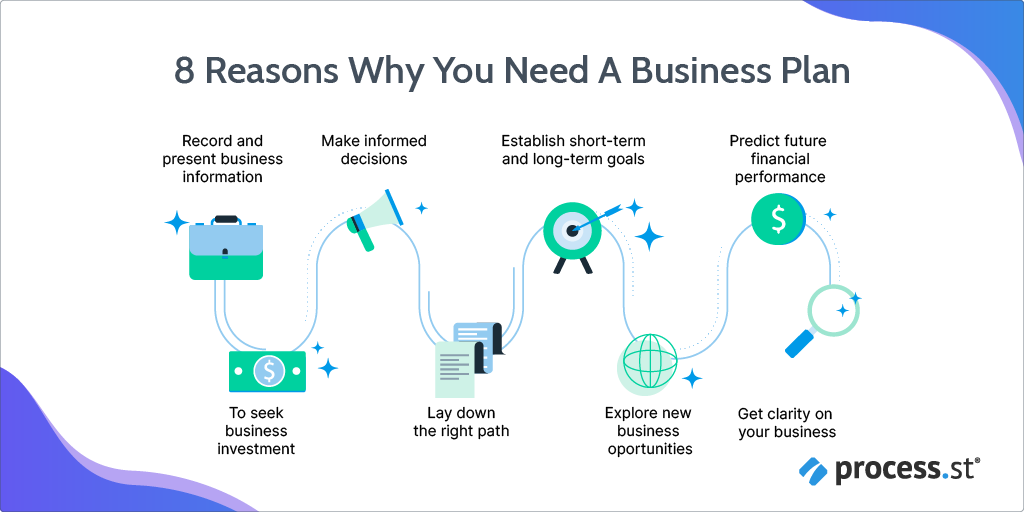
Record and present business information
The primary intent of a business plan is to record and communicate information. It must document the business goals and the methods to attain those goals in a structured manner. It keeps businesses on track with their objectives.
A blueprint for seeking business investment ️
Whether you are a fledgling start-up or an established business seeking expansion or diversification, writing a winning business plan acts as a magnet to attract investors. It builds confidence and trust among investors about the lucrativeness of a business idea.
Lay down the right path ✔️
Not everything discussed verbally at an ideation stage transforms into reality in a pragmatic environment. Jotting down a business plan differentiates achievable from impracticable based on market dynamics, opportunities and threats, and company’s strengths and weaknesses. It sets the right track for business growth.
Establish short-term and long-term goals
A business plan sets down short-term and long-term goals and the direction to accomplish them, right from baby steps to giant leaps. It becomes a basis to revisit the goals from time-to-time and make iterations depending on the present scenario.
“Any business plan won’t survive its first encounter with reality. The reality will always be different. It will never be the plan.” – Jeff Bezos, CEO of Amazon
Get clarity on your business
A frequent question that pops-up in business discussions is: “Are we doing it right?”
A well-articulated business plan brings insightful knowledge on each aspect of a business – from what it has to offer to how to market the offerings.
Make informed decisions
A business plan is a reality check to track what is being fruitful and what is causing hindrance. It paves the way to make a business sustainable.
Predict future financial performance
Financial projection is the spotlight of a business plan. It’s the carrot that captivates the eyeballs and tickles investors to fund a new business.
A promising business plan talks about the company’s future financial performance – expenditure, profit, revenue, etc.
Explore new business opportunities
A business plan is a flexible document that enables learning on the go. It bolsters research and infuses businesses with new and more feasible business opportunities. It gives organizations a fresh outlook and ushers them to be a howling success.
How to prepare for a business plan
Now that we have answered the ‘what’ and ‘why’ of a business plan, let us move forward to solve the next riddle – how do you prepare it?
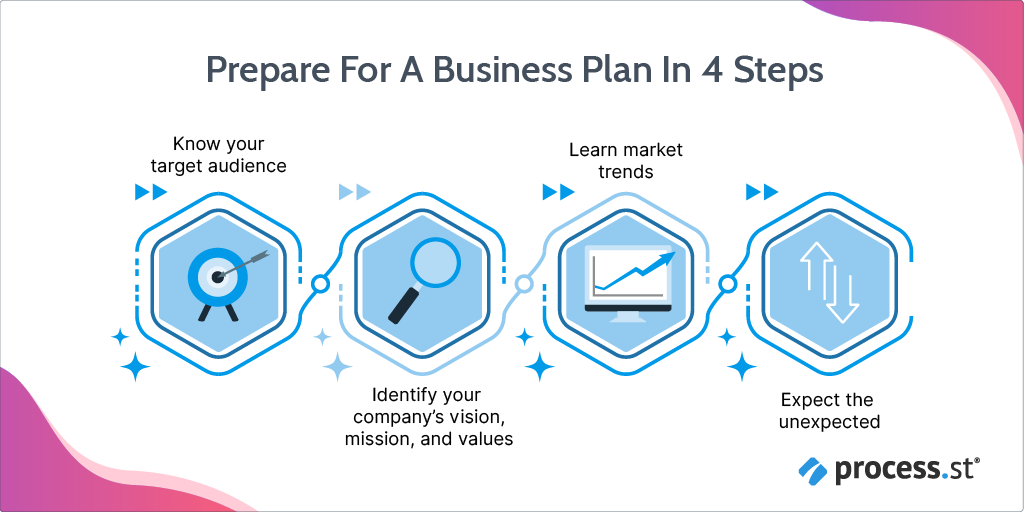
Identify your company’s vision, mission, and values
Start by answering and figuring out your business personality:
- What do you desire to be?
- How do you want to be perceived?
- What values put your business in motion?
This is your organization’s compass that acts as a foundation for the succeeding steps.
Know your target audience
Dig deep into:
- Whom are you going to cater to?
- What is your target market?
- What is the size and potential of the target market?
- What are the needs of a prospective customer?
- How are the needs addressed presently?
Learn market trends
Identifying market trends keeps businesses ahead of the game. Analysis of industry data leads to business growth and profitability in the long run.
Weigh in the impact of unforeseen circumstances
From financial turbulence to natural calamities and pandemics – a lot can go wrong in the future and leave a business shaking. Expect the unexpected and gird your loins for these testing times.
How to write a business plan
Creating a winning business plan increases the chances of success and spurs investors to fund your business.
According to a study published in Small Business Economics, entrepreneurs that create a plan are 152% more likely to start their business and appoint a registered agent and 129% more likely to push forward with their business beyond the initial start-up phase and grow it.
Here are the key components of an excellent business plan:
Executive summary
First impression is the last impression!
An executive summary is a crucial part of this document. It provides the essence of the whole plan:
- Company details;
- Size and scope of business opportunity;
- A description of your offerings and how it will solve the problem;
- Growth projection;
- Financial requirements.
It should be informative and able to spark readers’ interest to know more about the business plan.
Overview of the business
This section lists down information on:
- Your business;
- Your target market;
- Description of your products/services;
- Why and how your offerings are a great fit for prospective customers;
- Your capabilities to handle the demands;
- Your value proposition and competitive advantage.
…and all other related details.
Market analysis and strategies
Put forth a strong case built on the solid rock of data analysis and statistics – present data on target market size, industry trends, sales forecasts, and marketing strategy.
Operating plan
The operating plan highlights the operational requirements for the smooth functioning of a business. It includes facilities, supply chain management, inventory, manufacturing, shipment, logistics, staff management – everything under the sun that covers capital and expense (CapEx) requirements.
Growth plan
This section answers the question: “Where do you see the business going in the next few years?” It provides visibility to investors on the milestones and how you will make money in near future.
Marketing plan
Thee marketing plan section describes how to market the offerings to create and fulfill customers’ needs (who are the customers, product positioning, pricing policy, and promotional strategies?)
Management plan
This section outlines how your organization is structured and basically how strong you are together. It describes the skills, background, and responsibilities of the management team. It builds conviction that the business is in good hands and has a proficient human capital.
Financial plan and projections
This is the part where numbers become the king.
It draws up deets on inflow and outflow of money, sales forecast, profit and loss statement, balance sheet, cash flow statement, and budget expense. It discloses and forecasts the company’s financial goals, profitability model, and charts a course for the coming years.
Conclusion and appendix
Conclude the business plan by succinctly bringing out the key pointers – the business’s vision, mission, goals, strengths, and growth trajectory. Make it compelling and to-the-point.
Add relevant appendices to strengthen your business plan.
Pro tip: Use an all-inclusive ready-made business plan template document and Process Street‘s business plan workflow to create unbeatable business plans.
Business Plan Workflow
Click here to access the Business Plan Checklist!
Types of business plans
There are varying types of business plans depending on the purpose and usage:
- Business plan for start-ups
A winning start-up business plan can be a game-changer to attract funding from investors. It should weave all key components to make it a promising investment – company overview, products/services, estimated costs, market evaluation, competition insights, risk analysis, cash flow projections, marketing strategies, and the management team’s strengths. - Strategic business plan
It lays down the details of a company’s strategies to fulfill its goals. It outlines the company’s vision, mission, strategy, and goals, the driving force for success, and the timelines. - Internal business plan
This plan moves the needle and steers focus on in-house planning and growth. It ensures that everyone grasps the company’s overall plan for growth. It prepares organizations to move forward by identifying and removing any blockages and assess and revise the strategies when required. - Operations business plan
It is an internal plan that maps out the nitty-gritties of a company’s operations plans and activities. - Development business plan
This is a development or an expansion plan of a business. It is used for both internal and external purposes. An external growth plan is written to attract investment from external sources. An internal development plan counts on its own business capabilities, revenue, and resources. It works as a guide to provide the right directions. - Feasibility business plan
A company scouts out a feasibility study when it plans to foray into a new venture, new product, or a new market. It articulates: How well will the product or service perform? Is the business promising? What is the expected return on investment (ROI)? - What-if business plan
At a point where you face unordinary conditions, you need a variation on the existing plan. A what-if business plan arranges to fall back on a contingency plan when things go sideways. For example, an unexpected surge in demand, new competition, drop in market size, etc.
What is a business proposal?
A business proposal is the mantra that draws you closer to win a customer or bag a project.
Generally, it is a formal response to a Request for Proposal (RFP) sent by a prospective client looking for the right solution to their problems. It explains the particulars of a seller’s offerings and convinces the buyer that the proposed solution is the gateway to their business’s success and productivity.
“And, after all, winning business is what writing proposals is all about.”― Tom Sant, Persuasive Business Proposals: Writing to Win More Customers, Clients, and Contracts
A business proposal comprises of four main points:
- What are the challenges of prospective clients?
- How can our solution solve their problems?
- Why should they choose us over others?
- What are the best pricing options available?
Why do you need a business proposal?
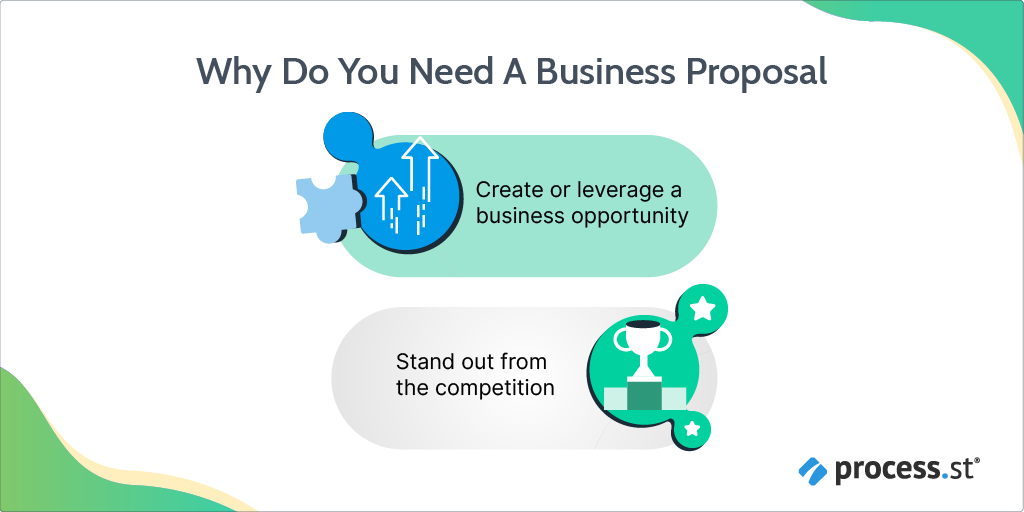
A business proposal is a testimony in itself that asserts, “I am the best you can get.”
Here are the reasons why you should and must make a business proposal:
- Create or leverage a business opportunity
The prime motive is to win, win, and win! It is a medium to encash a business opportunity by putting forward an I-can’t-say-no-to-this proposal. - Stand out from the competition
It persuades the prospects that you are way ahead of other rivals in the industry in terms of the value you offer.
How to prepare for a business proposal
The heart of preparedness is research and further research. After all, the devil is in the details.
Talk to prospective customers, visit their website(s), read published articles, and be a know-it-all for your prospective clients.
Sort out the ‘who’
First and foremost, dig every possible information about the client:
- Who is the client (its vision, mission, and goals)?
- What does it produce?
- What are its key markets and target customers?
- What are its business growth plans?
- Which markets is it presently serving?
- Also, figure out the kingpins of a proposal approval process. This will help you to create a comprehensive proposal with all the necessary answers expected by the decision-makers.
Understand the challenges
Find what’s bothering them and what is causing hindrance to their business success. Learn about their existing solution and its challenges.
Stitch the glitch and offer the best solution
After a thorough review of all the points mentioned above, find the best solution to your prospective client’s problems.
List down key differentiators
This will help you to beat the competition in the dust. It draws a comparison chart and puts you in a superior position.
According to Gray Mackenzie, founder of GuavaBox,
“Prior to submitting a proposal, make sure you have clearly defined all the major points verbally with the potential customer. By discussing the scope, cost, timeline, and details prior to submitting a written proposal, you can uncover objections earlier in the process.” – Gray Mackenzie, 10 Sales Experts Share Their Best Business Proposal Tips
How to write a business proposal
Let’s get down to the fundamental elements that form a business proposal. Learn how to create a business proposal that stands out and close sales.
Title page/Cover page
The name says it all.
Pretty easy-peasy thing to understand, right? After all, you have been creating the title pages since school days.
Still, make a note: Always write a gripping title that intrigues prospective clients’ interest and urges them to read on.
Other components that should be included on the title page are:
- Your company name and logo;
- Prospective customer’s name;
- Submission date.
Table of contents (TOC)
As the name suggests, a TOC is a well-structured layout of the document. It helps to skim and scan and navigate speedily through different sections of a business proposal.
Executive summary
It sets the tone for a proposal and makes the reader inquisitive about reading subsequent sections. It sums up the entire business proposal – the purpose of sharing the proposal and why and how your solution is the right fit for the prospective client. Leave no stone unturned to boast about your offerings in the executive summary.
Details of offerings
This is an in-depth description of the products or services your company has to offer.
How will the offerings solve the client’s problems?
This explains why your products/services are the right fit to address a prospective client’s needs and why it is a better alternative than the competition.
The methodology/implementation of offerings
This section is a blanket explanation of how the promised deliverables will be executed. It provides step-by-step clarity on each action along with timelines. It gives the client peace of mind and builds trust and confidence in the offering.
Pricing, payment, and legal matters
Here, you talk about the pricing structure, applicable taxes, payment schedule, cancellation policy, and how you plan to solve the legal matters (if any arise in the future).
Here are some tips for this section:
- Ensure that the pricing details are concise and complete.
- Providing a comparison chart with different pricing options helps to make decisions faster.
- Don’t go overboard with pricing, and also, don’t underrate yourself.
- Always refer to the RFP and verify if every request has been fulfilled.
- Separate out and create a new legal section if your business demands an extensive list of legal requirements.
Details about your company
This is an exhaustive overview of your company. Don’t forget to add relevant customer testimonials, case studies, or success stories to build your case among prospective customers.
Signatures and Call to action
This is the moment that gets butterflies in your stomach; the closure. This is the concluding part of a business proposal. Here (if all your prayers get answered), you and your client sign the proposal and secure the deal.
Hurray!
Pro tip: Once you send the business proposal, don’t sit idle in your cocoon day-dreaming of winning the proposal. Always proactively do follow-ups with the prospective clients and clarify their doubts.
For start-ups or small businesses, drafting a business proposal can be an unnerving experience. They work fingers to the bone to write a perfect business proposal. Spending too much time on it might lead to missing the deadline and eventually losing out on a golden opportunity.
According to a report by Better Proposal, sending a business proposal within 24 hours increases the likelihood of winning the deal by 25%.
Here’s the secret sauce to speedily create flawless business proposals:
First, pick a professionally vetted and ready-to-use business proposal template and draft a business proposal like a cakewalk. Such as the Business Proposal Template included below.
Next, always use Process Street‘s super-powered business proposal template checklist and ensure no step gets missed in the process.
Business Proposal Template Checklist
Click here to access the business proposal template checklist!
It even turns out a blessing for big businesses since they have to draft multiple proposals all the time. Templates and checklists save a lot of time, enhance productivity, and increase the chances of success.
Types of business proposals
Majorly, there are two types of business proposals:
Solicited business proposal
Also known as an invited business proposal, it comes into play when a buyer, or a company, outlines its requirements and requests suppliers to present an offer. It can be a response to a public tender issued by big corporations or government agencies.
Alternatively, a solicited business proposal can also be submitted as a response to the RFP shared by a prospective client.
The difference between the two is that while the earlier one is open to all bidders, the latter’s scope is limited as it is shared with shortlisted suppliers.
Pro tip: Do a thorough check before submitting an invited business proposal. Missing out on-minute details can kick you out from their consideration list.
Unsolicited business proposal
An uninvited or unsolicited business proposal is a proactive attempt to create a business opportunity. This proposal is sent to prospective clients without being asked.
The good news is, there are slim chances of your rival sending a business proposal simultaneously, so less or no competition.
The bad news is, it might breathe in the customer’s inbox for a few days and then, without being read, depart to the heavenly abode -the trash folder.
But still, like a cold call, it leaves some impression on prospective clients and shoots up the chances to cut a deal in the long run.
Pro tip: An unsolicited business proposal is mostly sent through emails. Make certain to write an attention-grabbing headline and a convincing explanation to draw attention.
Business plan vs. Business proposal: What are the differences?
Here’s a comparison chart that distinguishes between business plan and business proposal:
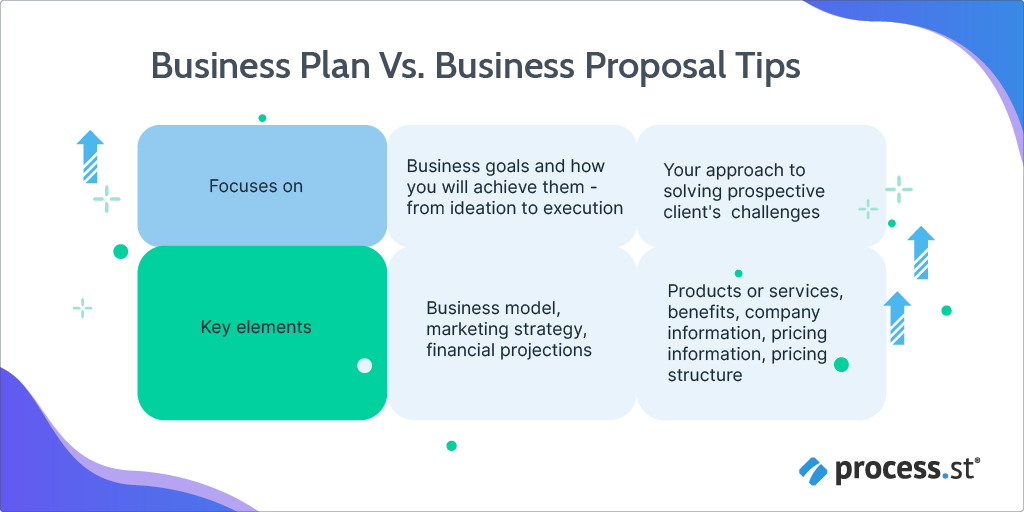
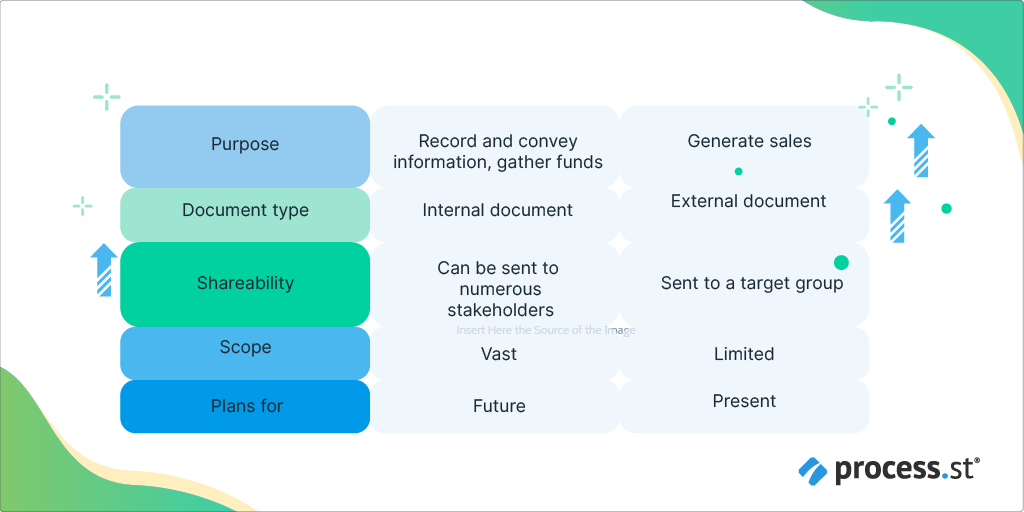
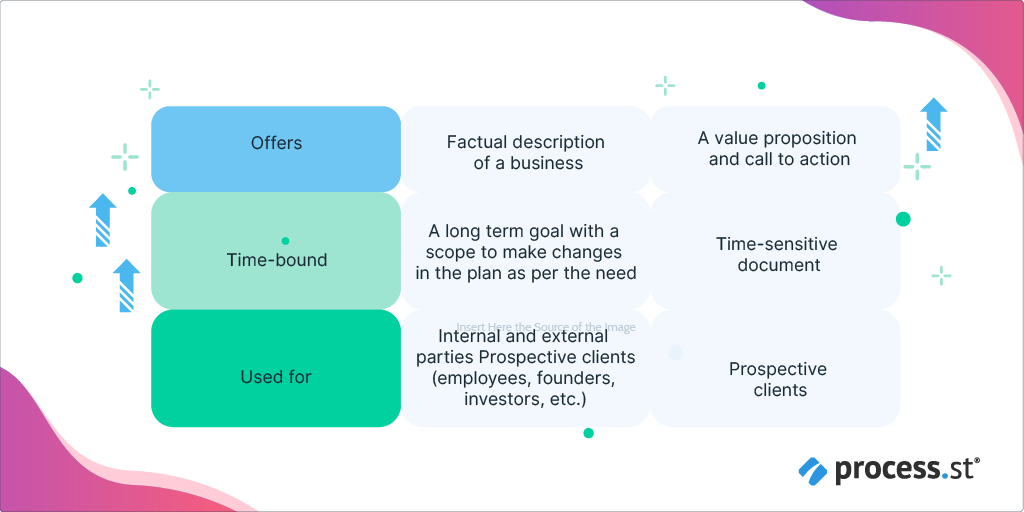
Bonus: How to make ‘wow’ business plans and business proposals
Here are the secret ingredients to make awesome and captivating business plans and proposals:
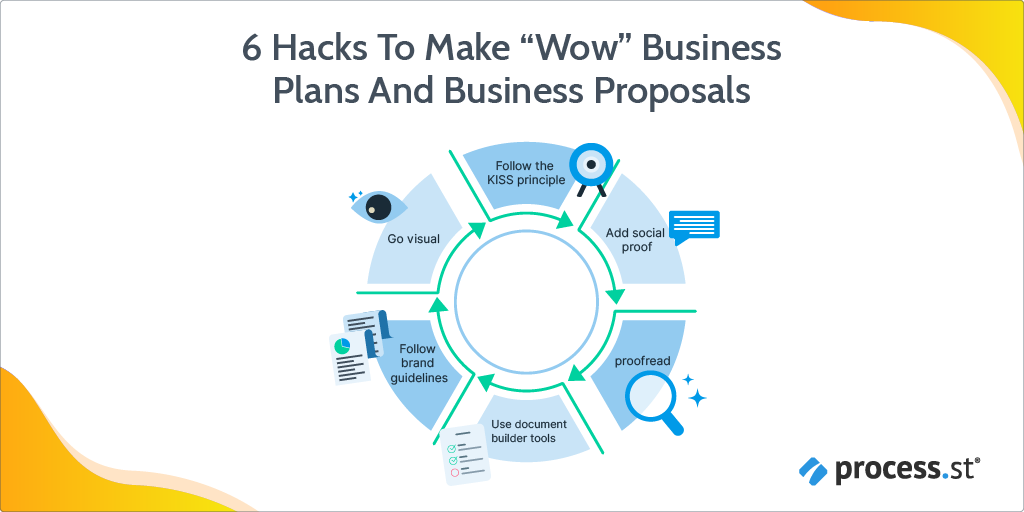
Follow the principle of KISS (Keep it simple, silly)
This is not the right place to brag about your vocabulary skills. You want the prospective customer to focus on reading rather than wasting time looking up for a word.
Always remember! Communication is the key.
So, go simple and ditch those heavy jargons.
Go visual
Don’t wear-out the pupils of your prospects with long-winded documents. Capitalize on the multisensorial abilities of humans as well.
Visuals increase people’s desire to read content by 80%.
Leverage the power of visuals and make your document easily graspable by adding graphs, infographics, flowcharts, tables, images, and videos.
Add social proof
Do not forget to add positive feedback or customer testimonials. If similar projects have been delivered in the past, do add relevant links and case studies of that work. It helps to build trust and strengthen your case.
“Make sure you have great success stories that you can share with potential clients. At the end of the day, most, if not all, potential clients want to know you will provide value to them and generate positive ROI.” – Mathew Bivens, Podcast and marketing consultant, 10 Sales Experts Share Their Best Business Proposal Tips
Proofread ️
Ensure the document is free from grammar and spelling errors.
Follow brand guidelines
Your document should reflect your brand. Bring consistency in all your documents and design them as per the brand guidelines.
Use document builder tools ️
Time is money!
The likelihood of getting a ‘yes’ on your business plans and business proposals depends on how fast you can create a flawless document.
Empower your organization with a smart and all-in-one document builder tool like Revv – create, communicate, collaborate, and close your documents in no time.
Winding-up: Key takeaways
Business plans and business proposals are two different worlds with distinct purposes and goals. But, both play a prime role in increasing the odds of business success.
People often get the wrong end of the stick and ask for a business plan when they mean business proposal or vice-versa.
But, we don’t need to worry about that since we are now clear on what is what.
Cheers to us!
P.S: Don’t forget to subscribe to the Process Street blog to get notified of our upcoming articles. We also have a podcast “Tech Out Loud” featuring content written by respected industry leaders such as Peep Laja, Sujan Patel, Tomasz Tunguz, and more!
What is your take on business plans and business proposals? Have you ever got your wires crossed with these two terminologies? Don’t forget to post your comments below.







Molly Stovold
Hey, I'm Molly, Junior Content Writer at Process Street with a First-Class Honors Degree in Development Studies & Spanish. I love writing so much that I also have my own blog where I write about everything that interests me; from traveling solo to mindful living. Check it out at mollystovold.com.